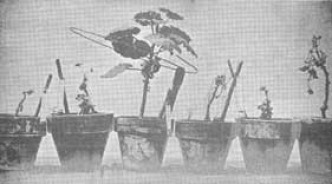
Big Antenna to increase the fertility of agriculture fields with the use of the electricity collected from the air.
Electroculture & Magnetoculture
Making crops grow larger and faster has been the primary concern of agriculture for millennia. All manner of cultivation techniques and technologies have been developed to fulfil this aim, from simple crop rotation to complex synthetic fertilisers. The enterprise of agricultural science is testament to this cause. It is therefore unsurprising to find that newly discovered technologies and phenomena have been readily applied to agricultural problems, no matter how abstract they may seem. Some of these applications are now used in everyday, orthodox farming practices, others are not. It is one of the unsuccessful applications of a new and developing technology to agriculture that is the topic of this paper, the attempt to use electricity as a 'fertiliser'.
From the mid-eighteenth century, enterprising individuals have tried to use electricity to boost plant growth because of the promise that such an inexhaustible 'substance' held. The eighteenth and nineteenth centuries saw 'Electro-Culture', as it came to be known, taking hold, with increasing efforts to prove that it worked. Many entrepreneurs involved with Electro-Culture saw statistically significant increases in the yields of their crops. The lavish claims they made gathered sufficient credence to prompt Lord Ernle, the president of the Board of Agriculture, later the Ministry of Agriculture and Fisheries (MAF), to found a committee in 1918 to see if Electro-Culture could be employed on a larger scale. Its institutionalisation, however, is the high water mark of the idea, with the Electro-Culture Committee disbanded in 1936 and the whole pursuit branded a failure. Although it saw a small resurgence in the mid-twentieth century, Electro-Culture is now very much a relic of the past. However, there is little proof that the idea is as absurd as it sounds. Much of the work carried out by the Committee saw considerable success, and the mass of results achieved then, and in the 1960s and 1970s, suggest that the growth increases seen by the Electro-Culturists were real.
Read more : http://www.electrocultureandmagnetoculture.com/history.html
Georges Lakhovsky, Bioelectric Pioneer (1869-1942)
a Russian engineer who had emigrated to France before World War I. In 1929, Lakhovsky published a book in French called The Secret of Life.

Photo above : You see a Lakhovsky antenna placed round this plant. This plant was sick and became again healthy by the use of this antenna. Experiment done by Yannick Van Doorne, 2003.
Love Always
mudra









